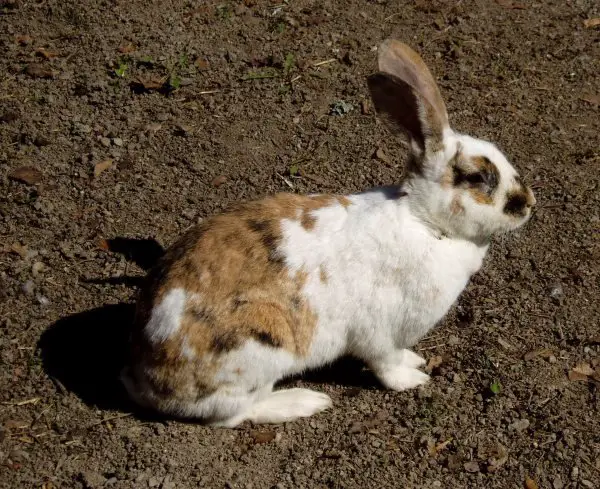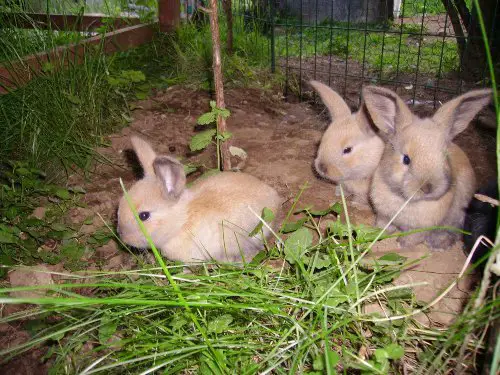Last Updated on June 12, 2023 by Emma Reynolds
Sweden has given rise to a number of different breeds of rabbits. The one that we want to talk to you today about is the Gotland Rabbit, and this one has a very cool history.
Contents
The History of the Gotland Rabbit
The history of the Gotland Rabbit is somewhat murky. However, we can tell you that it does not come from the island of Gotland just off the coast of Sweden. Although, we will talk more about why it has the name in a short while.
In the 1500s, Sweden was heavy into the raising of rabbits.
There was an abundance of them in the country, and they provided a great source of food and fur. As a result, people were always trying to breed better versions of the rabbit.

Since the Gotland Rabbit started to be developed over 500-years ago, it is unlikely that we will ever know what went into the creation of the breed. Most people didn’t care what they were combining back then.
The Gotland Rabbit is known as a landrace animal.
Without going into detail on what a landrace animal is (we could easily write thousands of words on that!), all you need to know is that the Gotland Rabbit is a naturally bred rabbit, mostly through agriculture, that has evolved to do well in the Swedish environment.
This is a breed that couldn’t really be developed anywhere else other than Sweden.
Of course, since it was developed for farming purposes, when the need to farm rabbits plummeted, the breed started to rapidly die out. In fact, up until 50-years ago, we thought the Gotland Rabbit was extinct.
However, a small population was discovered roaming about in the wild on Gotland. Hence the name. It is still a critically endangered breed, but it is certainly better than being extinct, right?
The Appearance of the Gotland Rabbit
Due to the way in which the Gotland Rabbit was initially developed, it is an incredibly diverse breed. This is, in part, what made it so good as a breed for meat and fur. A lot of healthy rabbits went into the breed, and this caused a lot of genetic diversity.
The Gotland Rabbit is unique insofar as the fact that both the buck and the doe will look a bit different. Although, they will always weigh around 9 lbs.

The doe is longer than the buck, with the buck having a somewhat more compressed look to it. The shape of their head will be a bit different too.
The ears on both sexes will be of a medium-length. They will always be pointed. The eyes will be incredibly wide.
Due to the unique way in which the Gotland Rabbit was registered as a breed, there are a lot of colors for both the fur and eyes out there. All of them are allowed at shows. This, again, makes this breed unique.
As a Show Breed
A lot of people still show the Gotland Rabbit. Although, it is important to note that the bulk of these rabbit shows are only going to happen in Sweden. This is a breed that is relatively unheard of outside of the country.
In fact, even in Sweden, it isn’t really a rabbit that you will encounter all that much.
Now, this is where the difficulty lies. This is a rabbit that evolved due to the wild environment. It was not part of a breeding program. As a result, there were no real criteria for what could be regarded as a Gotland Rabbit, mostly because there were rabbits that looked similar to the Gotland but would never be regarded as such.
When the breed was first discovered, a stud book was opened where breeders could register the Gotland Rabbit breed that they owned. This stud book was eventually closed in 1993.
The only rabbits that are classed as Gotland rabbits are rabbits that have descended from the original rabbits listed in this book.
This means that if the rabbit descends from rabbits that are clearly Gotland Rabbits but were never actually registered, then it is not a show quality rabbit. In parts of Gotland, you may see the Gotland Rabbit running around, but since it is wild, it is not classed as that breed.
Confusing, yes?
The result is that this breed can be very expensive to show. Each new bunny needs to be recorded too. It is a great rabbit to show, but certainly not for everybody.
The Gotland Rabbit for Meat and Fur
Because this was a meat rabbit breed that was initially developed with meat and fur in mind, it should probably come as no surprise that it can still be used as a commercial breed.
There are some people that will even raise the Gotland Rabbit specifically for that. However, if you are looking to purchase it from outside of Sweden, then it is probably going to be a bit more expensive.
Your best hope, in that case, would be to purchase something that would normally be regarded as Gotland Rabbit, but descends from rabbits that were never officially registered.
The Gotland Rabbit as a Pet
The Gotland Rabbit makes a fantastic pet. Since this is a breed that developed in the wild (mostly), it has gone through the process of natural selection. This means that there are no health issues associated with the breed.
These were wiped out. It also means that it is a generically diverse rabbit breed, and this creates unique rabbits that can look different when you breed them. It is just a fun bunny to own.
Of course, being a genetically diverse breed does have a couple of issues.
Perhaps the main being that the personality can differ drastically from rabbit to rabbit. However, most people will report that their Gotlands are quite calm and friendly, so we have no reason to believe that they would be anything but the same for you.
Other than this, just make sure they have a decent hutch and area to run around in. This rabbit can live both indoors and outdoors. If you can do that, then you have a great bunny on your hands.
Related articles:
– Silver Marten Rabbit
– Altex Rabbits
– English Lop Rabbits
Emma is a young, enthusiastic veterinary assistant based in Portland, Oregon. She has a natural affinity for all things fluffy, with rabbits being her absolute favorite. She got her first rabbit, a Holland Lop named Pippin, at the age of 7 and has been head over heels for them ever since. Emma holds an Associate Degree in Veterinary Science from the Portland Community College and has been working in a small animal clinic for the past 2 years.
